Paul Carl Friedrich Waechter, 1847 - 1893
August Puchler, 1864 - ca. 1932
by Brian Stevenson
last updated March, 2022
Having learned the trade of microscope manufacturing with Carl Zeiss, twenty-five year-old Paul Waechter left Jena to establish his own optical business in Berlin. Early advertisements indicate that Waechter emphasized production of microscopes designed to assay meat for the presence of Trichina spiralis nematodes, which had recently been recognized as a threat to public health. Soon afterward, he also produced several types of microscopes specifically designed for the burgeoning field of bacteriology. By 1890, Waechter’s business had grown to the extent that he needed to move to a larger space, in nearby Friedenau.
Waechter died when only 46 years old. His widow appears to have continued the business for a few years, aided by a former employee, August Puchler. Puchler acquired the Waechter business in 1900, retaining Paul Waechter’s name, and operated it until ca. 1931. Some years later, under various owners, the business moved to Potsdam, and later to Wetzlar.
A brief outline of addresses and dates for the Paul Waechter businesses:
1872: Paul Waechter established his optical business at 14 Wartenburg Strasse Berlin.
1874: Waechter moved to 19 Grüner Weg, Berlin.
1880: Advertisements indicate that the business address changed to 16 Grüner Weg. This was probably due to a revision of street numbers.
1882: Waechter relocated to 115 Köpnicker Strasse (also spelled Cöpnicker Strasse), Berlin in early 1882
1889: The business address changed to 112 Köpnicker Strasse, probably due to a revision of street numbering.
1890: Waechter moved to 21 Albe Strasse, Friedenau in January, 1890.
1893: Paul Waechter died on April 3. The business appears to have been continued by his widow, likely with the assistance of August Puchler.
1900: August Puchler and Paul Prasser purchased the Paul Waechter optical company.
1907: The partnership was dissolved, and the Paul Waechter optical company was continued by Puchler alone.
ca. 1940: Moved to Potsdam
1958: Moved to Wetzlar
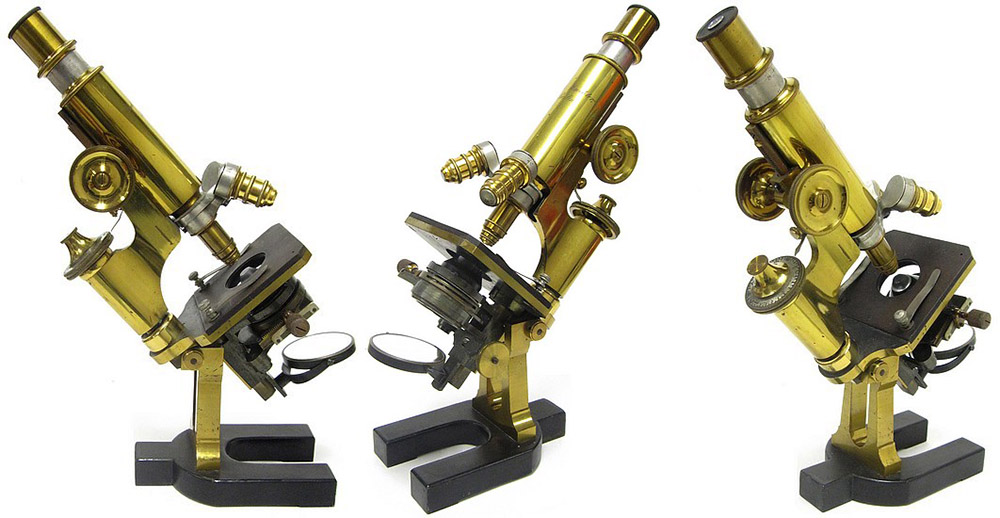
Figure 1.
A Paul Waechter Stand Ib, serial number 12416, engraved “Berlin”, indicating production prior to 1890, when Waechter moved to Friedenau. Adapted, with permission, from http://www.antique-microscopes.com/photos/Paul_Waechter_microscope_12416.htm.

Figure 2A.
A Waechter Stand IV, serial number 5752, marked “Berlin”. The bodies of Stands IV and V are identical, the difference between the two being the optics that were supplied. This microscope was accompanied by objective lenses 1 and 2, which screw together to make objective 4, and objective lens 7 (see Figure 14). Microscopes with essentially identical bodies were also sold by F.W. Schieck and Schmidt & Haensch (both also from Berlin), although with distinctively different objective lenses, suggesting that the bodies may have been manufactured by a single maker, then outfitted with optics by each retailer..

Figure 2B.
Waechter’s Stands IV and V have a fine focusing mechanism that consists of a micrometer thumbscrew that threads through the limb to adjust the tilt of the stage, which moves the specimen toward/away from the objective lens.

Figure 3.
Waechter’s Stand III, circa 1880-1890. Adapted for nonprofit, educational purposes from an internet auction site.

Figure 4.
Two examples of Waechter’s Stand Vb. The microscope on the right has a joint that allows inclination, while the example on the left and center has a solid limb. The left and center microscope has serial number 14586, and that on the right has serial number 16864. Both are engraved “Friedenau”, dating them to after 1890. Images adapted for nonprofit, educational purposes from internet auction sites.

Figure 5.
A Paul Waechter Stand VI, serial number 18526, and marked “Friedenau”. Adapted for nonprofit, educational purposes from http://www.bononiaemicroscope.com/en/the-microscopes/germany/109-waechter-18526-stand-vi.html.

Figure 6.
Paul Waechter Stand X (later renamed Stand IX). Serial number not known, but engraved “Berlin”. On the right it is shown with an apparatus designed for examining meat for Trichina cysts: two glass plates that clamp together with screws, which flattens meat specimens to permit examination with transmitted light. Adapted for nonprofit, educational purposes from http://www.museum-optischer-instrumente.de/waechter_trich.html.

Figure 7.
After 1890, this model was known as Stand X. This example has serial number 16981, indicating manufacture after the 1890 move to Friedenau. Adapted for nonprofit, educational purposes from http://www.museum-optischer-instrumente.de/mikroskop_x.html.

Figure 8.
A Stand XIII, signed “Berlin”. Paul Waechter was issued a patent for this trichinascope mechanism. The “Journal of the Royal Microscopical Society” described this in 1880, “the slide is composed of two circular glass plates, 5 mm thick and 8 cm in diameter, which are pressed firmly together by a metal knob at their centre. They thus form a compressorium at the same time. The under plate, which may of course be thickly covered with the preparations, is divided into four sections, which are numbered for identification. To prevent any fluid coming away, the under plate may be made a very little larger than the upper. These plates are turned with the finger about their axis (which is fixed to the stage so as to move from behind forwards, and vice versa), an arrangement which allows the examination of a continuous series of preparations lying in the peripheries of different circles 18 to 24 cm in circumference. When one periphery has been examined (which is indicated by a catch-spring), a rack and pinion moves the plates in a radial direction (as a rule it is best to begin with the inner circle), and they are again revolved; and so on until the last periphery has been examined. There is here the great advantage that in adjusting a fresh circle the size of the field corresponding with the power used can be taken into account. Thus the lowest power requires the rack to be moved three teeth, the medium power two teeth, and the highest power one tooth forward. When the plates are removed from the stage the instrument can be used as an ordinary Microscope. Images adapted for nonprofit, educational purposes from (left) an internet auction site and (right) http://www.bononiaemicroscope.com/en/the-microscopes/germany/106-waechter-stativ-xiii.html.

Figure 9A.
A Paul Waechter “Salon” or “School” microscope, based on the design of Conrad von Rappard. Adapted for nonprofit, educational purposes from http://www.museum-optischer-instrumente.de/berliner_demo.html.

Figure 9B.
A Waechter “Small Dissecting” microscope. Mounted in a small, wooden box, the lid of which unfolds to make hand rests. Adapted for nonprofit, educational purposes from an internet auction site.

Figure 9C.
A ca. 1920 portable microscope by Waechter, Friedenau, serial number 25160. The instrument is mounted inside the case bottom. The lid serves as the stage, with a set of stops and a mirror mounted to the underside. Adapted for nonprofit, educational purposes from an internet auction site.

Figure 10.
A microscope slide that was sold by Paul Waechter. Adapted for nonprofit, educational purposes from Rosenbauer, “Mikroskopische Präparate”.

Figure 11.
Engravings of the microscope designs that Paul Waechter designated Stand I and Stand III in 1882 (left and right, respectively). The designs of those stands had changed significantly by the time of Waechter’s 1903 catalogue (Figure 14). From Leopold Dippel’s “Das Mikroskop und Seine Anwendung”.

Figure 12.
1884 engraving of the design that Waechter then called Stand X (see Figure 6). By 1903, this was renamed Stand IX (see Figure 14). From “Humboldt: Monatsschrift Für Die Gesamten Naturwissenschaften”
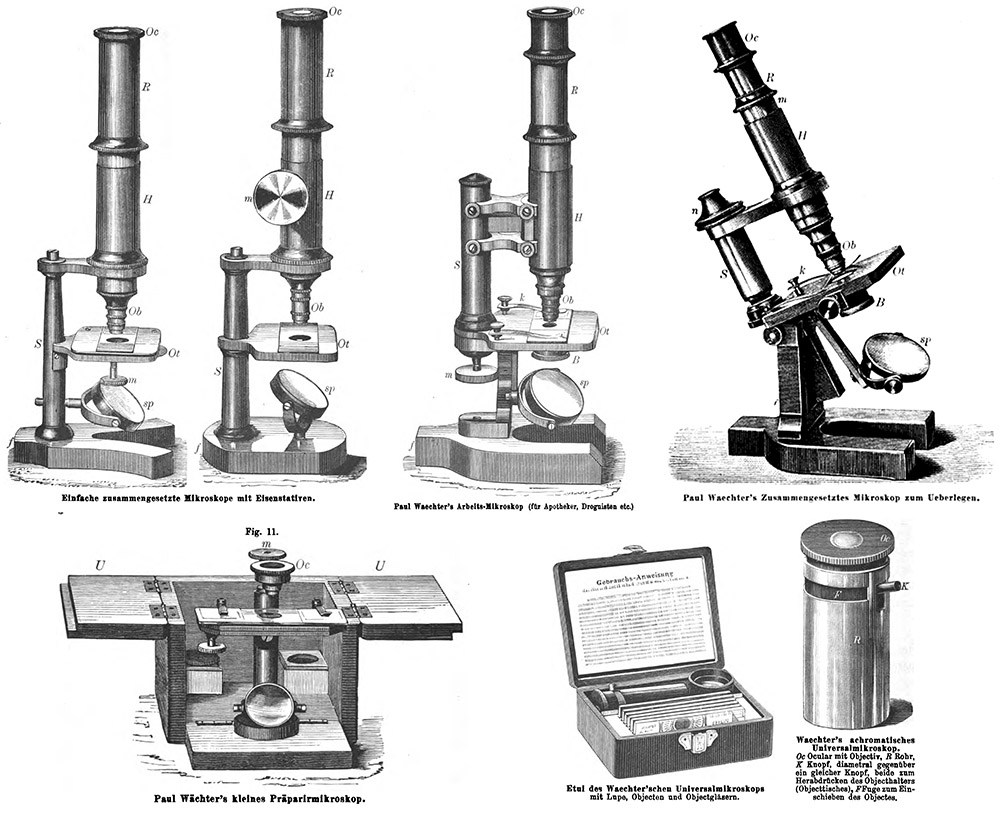
Figure 13.
1886 engravings of Waechter microscopes, from that year’s edition of Hermann Hager’s “Das Mikroskop und seine Anwendung”. None of the illustrated microscopes were described by stand number.





Figure 14.
Paul Waechter microscopes and lenses offered in 1903, from that year’s catalogue of Henry Heil, St. Louis, Missouri, USA.
The record of Paul Waechter’s April 3, 1893 death stated that he was then 46 years old. A published family tree gives his birth date as January 1, 1847, which is consistent with Waechter’s age at death.
His death record further states that Paul Waechter was born in Rudolstadt, Thuringia, son of Robert Albert Gottfried and Thekla (née Bragge) Waechter. Rudolstadt is approximately 40 kilometers (25 miles) from Jena, the site of Zeiss’ factory. Father Robert was a professor and educational inspector.
Paul Waechter’s advertisements declare the he founded his business in Berlin in 1872. Consistent with that date, Waechter is not listed in the 1872 Berliner Addressbuch, which would have been published in late 1871/early 1872.
That same year, he began a family: daughter Wanda Valesca Margarethe Dreger was born on October 9. Carl and the girl’s mother were not married (Wanda’s baptism record described her as “unehelich” (illegitimate)). A year and half later, on April 7, 1874, Carl Waechter married Wanda’s mother, Marie Sophie Caroline Dreger.
Berliner Addressbuchen for 1873 and 1874 list Paul Waechter’s business address as 14 and 13 Wartenburg Strasse, respectively. The directory for 1875 (published in late 1874) shows that he had moved to 19 Grüner Weg. That same address appeared in his advertisements from 1875 through 1880 (Figures 16-18). Advertisements from 1880 indicate that the shop was still on Grüner Weg, although the building number had changed to 16. This was probably due to the city revising their numbering system.
The 1882 Berliner Addressbuch reports that Waechter was still located at Grüner Weg at the time of publication, in late 1881. A move came shortly afterward, as advertisements from May, 1882 onward show that Waechter had moved his works to Köpnicker Strasse (also spelled Cöpnicker Strasse, Figure 19). This was about 9 kilometers (5 1/2 miles) from Grüner Weg, and very close to the center of Berlin. The initial number of the building was 115, but changed to 112 in 1889. Advertisements from 1882 indicate a Gold Medal to Waechter, although I have yet to identify the source of that award (Figures 20-21).
Waechter moved to a larger space in the Berlin suburb of Friedenau during January, 1890. Initial advertisements listed two addresses: 21 Albe Strasse and 19 Nied Strasse. These were back-to-back lots on parallel streets, as can be seen in a highlight from an 1891 advertisement (Figure 15). Later advertisements listed on Albe Strasse, implying that the main entrance to the shop was on that street. The house on Nied Strasse appears to have been the Waechter home. An advertisement from early 1890 stated that Waechter had produced 12500 microscopes by that time (Figure 24).

Figure 15.
Detail from an 1891 advertisement, showing the Waechter buildings on Albe Strasse (foreground) and Nied Strasse (behind). The Nied Strasse building is labeled “Villa Waechter” in this picture; it appears to have become the Waechter’s home, while the Albe Strasse building was the factory and shop.
Paul Waechter died on April 3, 1893, when 46 years old. His death record is shown as Figure 27. If any reader can decipher the handwritten German for his cause of death or other details, I will be grateful for that information.
It appears that the Waechter optical business was continued by Paul’s widow. Berlin directories list S. Waechter as the inhabitant of 21 Albe Strasse until 1901. Employee August Puchler is reported to have been elevated to manager during this time.
The business was purchased by Puchler and Paul Prasser in 1900. The Puchler-Prasser partnership ended in 1907, with Puchler continuing the business alone.
Puchler was probably the August Wilhelm Hermann Puchler who married Josepha Twardy in Berlin on May 8, 1893. Their marriage record describes the groom as an “optiker”. The date of this marriage would be consistent with an increase in Puchler’s finances upon assuming management of the Waechter business. The marriage record also states that Puchler was born on April 15, 1864. He was still alive, and working as an “optiker”, in 1931, according to that year’s Berliner Addressbuch. Puchler is not listed in subsequent issues, although the Waechter business remained at Albe Strasse through at least 1936 (Figure 31), suggesting that Puchler may have retired or died in 1831.
The Paul Waechter business was moved to Potsdam, probably in the later 1930s or the 1940s, then to Wetzlar in the 1950s.

Figure 16.
An 1875 advertisement from Paul Waechter. He moved from Wartenburg Strasse to Grüner Weg during 1874. From Franz Ziemann’s “Leitfaden für die Praktische Mikroskopische Untersuchung des Schweinefleisches auf Trichinen”.

Figure 17.
An 1876 advertisement, from Hermann Hager’s “Das Mikroskop und Seine Anwendung”.

Figure 18.
1880 advertisements from “Pharmazeutische Zentralhalle für Deutschland”.

Figure 19.
1882 advertisements with Waechter’s Köpnicker (Cöpnicker) Strasse address, to which he moved in early 1882. From “Pharmazeutische Zentralhalle für Deutschland”.

Figure 20.
An 1882 advertisement from “Pharmazeutische Zentralhalle für Deutschland”.

Figure 21.
An 1882 Christmas advertisement, from “Pharmazeutische Zentralhalle für Deutschland”. Waechter states having won a Gold Medal in this and other advertisements of the time, but I have not discovered the source of that award.

Figure 22.
An 1886 advertisement, noting that Waechter had studies under studied under Dr. Carl Zeiss, and had founded his own business in 1872. From Hermann Hager’s “Das Mikroskop und Seine Anwendung”.

Figure 23.
January 1, 1890 advertisement, showing Waechter’s address as Köpnicker Strasse. From Zeitschrift des Allgemeinen Oesterreichischen Apotheker-Vereines.

Figure 24.
February 1, 1890 advertisement, by which time, Waechter had moved to Albe Strasse, Friedenau. This advertisement notes that Waechter had manufactured 12500 microscopes by this time. From Zeitschrift des Allgemeinen Oesterreichischen Apotheker-Vereines.

Figure 25.
An 1891 advertisement, illustrating Waechter’s buildings at 21 Albe Strasse (front) and 19 Nied Strasse rear). From “Jahresbericht über die Fortschritte in der Lehre von den Pathogenen Mikroorganismen”.

Figure 26.
An 1893 advertisement, showing a Stand II microscope. From “Jahresbericht über die Fortschritte in der Lehre von den Pathogenen Mikroorganismen”.

Figure 27.
Paul Waechter’s death record, which provides a number of his vital statistics. I thank Erich Traugott for translating the record.

Figure 28.
An 1894 advertisement, showing a Stand I microscope. From Carl Friedlaender’s “Mikroskopische Technik”.

Figure 29.
Records of the transition of ownership from the Waechter family to August Puchler. Top, an excerpt from the 1900 “Der Berliner Addressbuch” for 21 Albe Strasse, Friedenau, showing occupation of that address by S. Waechter (presumably Sophie, his widow), and a 1900 notice that the business had been purchased by Puchler and Paul Prasser (translated: “The Paul Waechter optical instrument factory in Friedenau, which was founded in 1872, has been transferred by purchase to Messrs. Prasser and Puchler”.). Middle: Excerpt from the 1903 “Berliner Addressbuch”, noting that the Waechter business was owned by Prasser and Puchler. Bottom: 19007 notice that the partnership between Puchler and Prasser had been dissolved (translated: “The company of Paul Waechter, optical workshop, Friedenau, is from now on owned by August Puchler alone; Paul Prasser amicably resigned from the company.”).

Figure 30.
A 1905 advertisement, showing a Stand IVa. From “Der Mechaniker”.
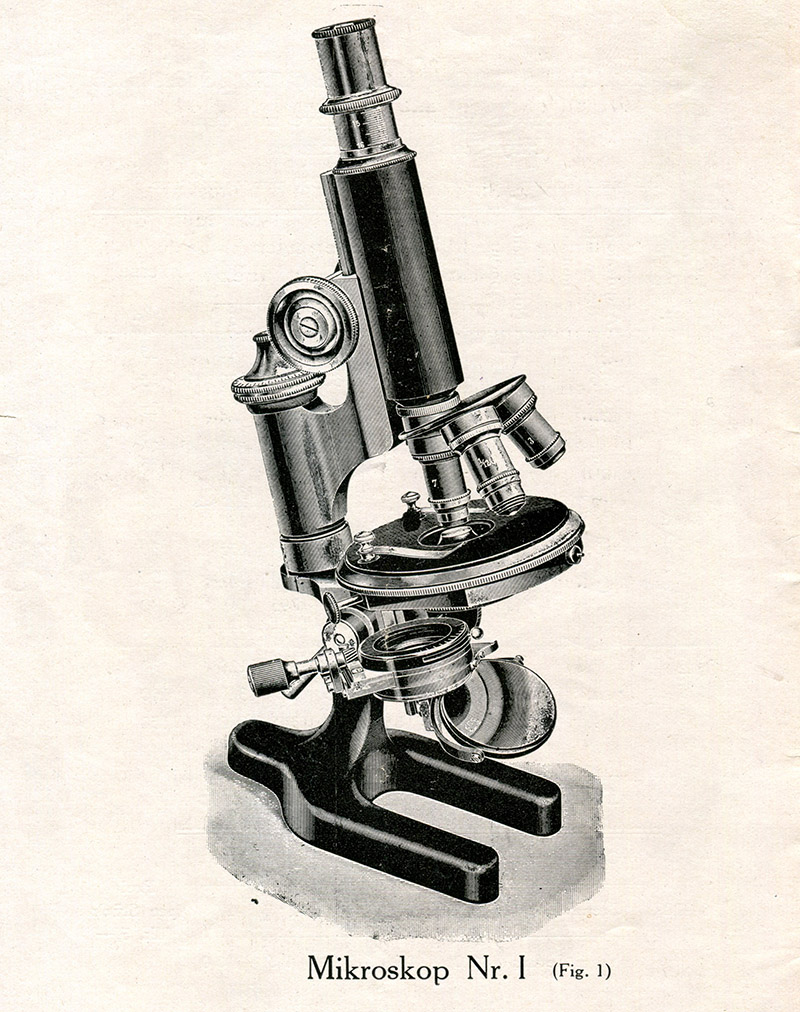



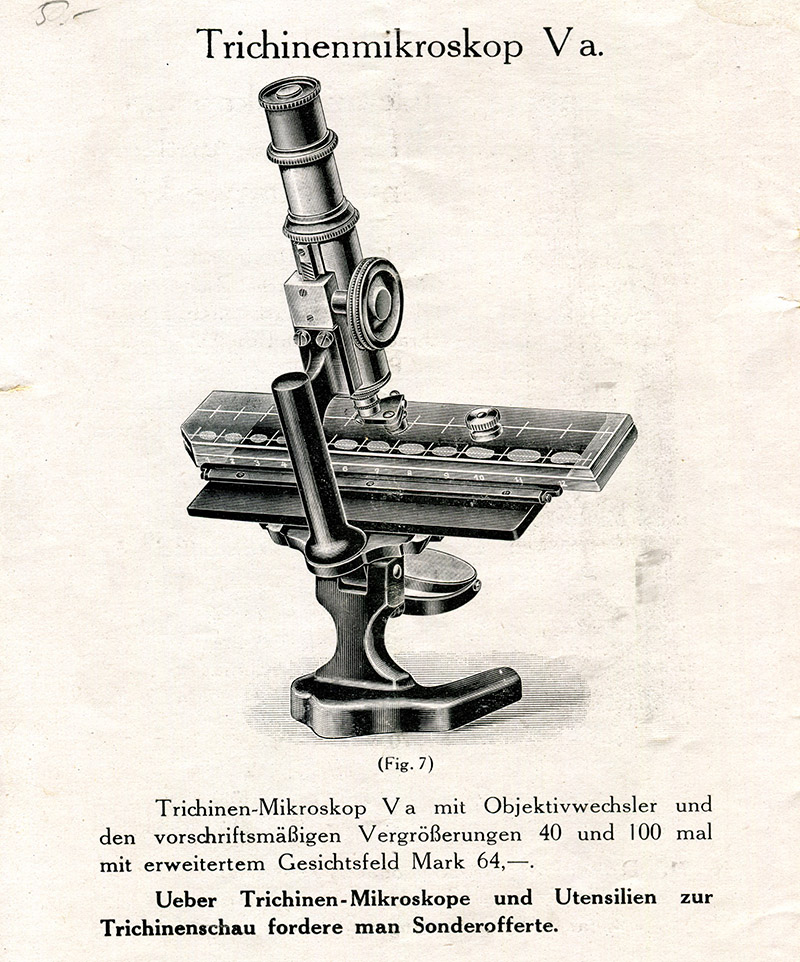

Figure 31.
Microscopes illustrated in a 1914 Waechter catalogue.
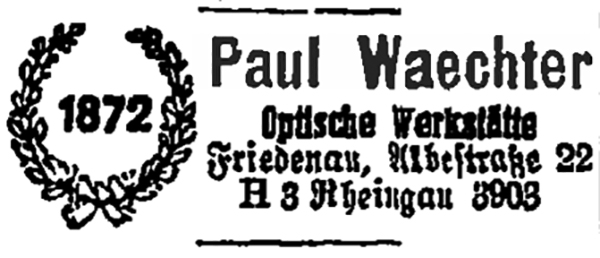
Figure 32.
A 1936 advertisement from “Der Berliner Addressbuch”. The business was still located in Friedenau at that time. August Puchler was last recorded as being associated the Waechter business in the 1931 “Berliner Addressbuch”.
Acknowledgements
Thank you to Allan Wissner for generously sharing images from his collection, and Erich Traugott for generously providing a translation of Paul Waechter's death record.
Resources
Baumgarten, P. (1891) Advertisement from Paul Waechter, Jahresbericht über die Fortschritte in der Lehre von den Pathogenen Mikroorganismen
Baumgarten, P. (1893) Advertisement from Paul Waechter, Jahresbericht über die Fortschritte in der Lehre von den Pathogenen Mikroorganismen
Berliner Addressbuch (1872 - 1940), accessed through https://digital.zlb.de/viewer/cms/141/
Birth record of August Puchler (1864) accessed through ancestry.com
Birth record of Wanda Valesca Margarethe Dreeger (1872) accessed through ancestry.com
Death record of Paul Waechter (1893) accessed through ancestry.com
Dippel, Leopold (1882) Paul Waechter, Das Mikroskop und Seine Anwendung, F. Vieweg und Sohn, pages 483-485
Friedlaender, Carl (1894) Advertisement from Paul Waechter, Mikroskopische Technik, Fischer’s Medicinische Buchhandlung, Berlin
German birth and other records, accessed through ancestry.com
Hager, Hermann (1876) Advertisement from Paul Waechter, Das Mikroskop und Seine Anwendung, J. Springer, Berlin
Hager, Hermann (1886) Das Mikroskop und Seine Anwendung, J. Springer, Berlin, pages 8, 37-41, 44, 53, 220, and 241, J. Springer, Berlin
Henry Heil Chemical Co (1903) Illustrated Catalogue and Price-list of Chemical Apparatus, Saint Louis, Missouri
Humboldt: Monatsschrift Für Die Gesamten Naturwissenschaften (1884) Neues Mikroskop, Vol. 2, page 456
Journal of the Royal Microscopical Society (1880) Trichina-Microscopes - Hager's, Schmidt and Haensch's, Waechter's, and Teschner's, Vol. 3, pages 711-716
Journal of the Royal Microscopical Society (1882) “Waechter’s (or Engell’s) Class or Demonstrating Microscope”, Series 2, Vol. 2, page 398
Kosmos (1947) “Paul Waechter & Co., Potsdam, Paul Waechter & Co., Wetzlar”
Marriage record of Paul Waechter and Marie Sophie Caroline Dreger (1874) accessed through ancestry.com
Marriage record of August Puchler and Josepha Twardy (1893) accessed through ancestry.com
Der Mechaniker (1905) Advertisement from Paul Waechter, Vol. 13
Der Mechaniker (1907) “Inhaber der Firma Paul Waechter, Optische Werkstatt, Friedenau, ist von jetzt an nur August Puchler allein; Paul Prasser ist unter Belassung seiner Kapitalien in der Firma nach freundschaftlicher l'obereinkunft ausgetreten”, Vol. 15, page 58
Pharmazeutische Zentralhalle für Deutschland (1880) Advertisements from Paul Waechter, Vol. 21
Pharmazeutische Zentralhalle für Deutschland (1882) Advertisements from Paul Waechter, Vol. 23
Zeitschrift des Allgemeinen Oesterreichischen Apotheker-Vereines (1890) Advertisements from Paul Waechter, Vol. 28
Zeitschrift für Angewandte Mikroskopie (1900) “Die Fabrik optischer Instrumente von Paul Waechter in Friedenau, bestehend seit 1872, ist durch Kauf an die Herren Prasser und Puchler übergegangen”, Vol. 5, page 60
Ziemann, F. (1875) Advertisement from Paul Waechter, Leitfaden für die Praktische Mikroskopische Untersuchung des Schweinefleisches auf Trichinen, W.G. Korn, Breslau











































